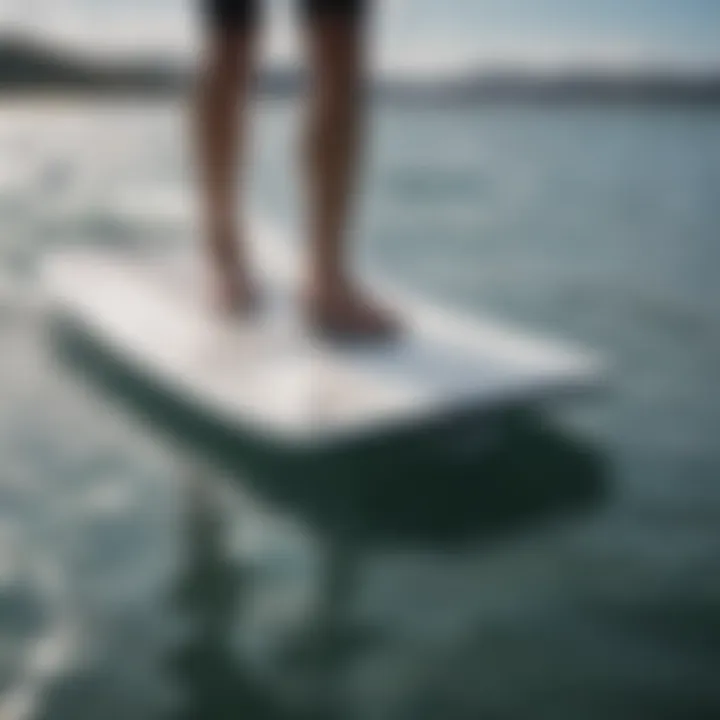Exploring Battery-Powered Foil Boards in Surfing


Intro
In the ever-evolving landscape of water sports, innovations continue to push boundaries, making experiences more exhilarating while also addressing environmental concerns. Among these advancements, battery-powered foil boards emerge as a significant leap forward. These unique devices combine the thrill of surfing with cutting-edge technology, allowing riders to glide above the surface of the water, harnessing electric propulsion for a distinctive surfing experience.
The spectacle of riding a battery-powered foil board is not just about enjoying the waves; it's a glimpse into the future of surfing. From their mechanical intricacies to the materials that compose their design, delving into the heart of these boards reveals a complex interplay of innovation and artistry. As surfers increasingly seek out gear that aligns with sustainable practices, understanding the potential environmental impact of these boards becomes paramount.
Comparing them with traditional surfboards offers insights into both their advantages and the challenges they pose. While many might revel in the immediate thrill of jetting across the water, questions arise: What does this mean for the natural environment? How do these boards affect the traditional surfing culture? These inquiries are not just academic; they are key to understanding the broader implications of introducing such technology into the surf scene.
As we embark upon this exploration, we will navigate the essential aspects of battery-powered foil boards, shedding light on market trends, user experiences, and the software that powers them. The goal of this discussion is to give surfers, instructors, lifeguards, and marine enthusiasts a well-rounded perspective on this fascinating development in the realm of water sports.
Preamble to Battery-Powered Foil Boards
The invention of battery-powered foil boards marks a significant shift in the way we engage with water sports. This cutting-edge technology turns traditional surfing into a new experience, allowing riders to glide over water with the effortless grace of a bird in flight. In this section, we will explore the importance of these boards, the benefits they bring to the surfing community, and the broader implications for water sports enthusiasts.
Definition and Overview
Battery-powered foil boards are essentially surfboards mounted with hydrofoils and powered by electric motors. These boards operate above the water by utilizing a wing-like structure that generates lift as the rider gains speed. Unlike traditional surfboards that rely solely on wave energy, battery-powered foil boards provide the rider with propulsion, thus opening a new realm of possibilities in flat bodies of water, lakes, and ocean waves alike.
The appeal of these boards lies not just in their performance but in their accessibility. Anyone can hop on a battery-powered foil board and enjoy the sensation of flying over water, regardless of skill level. They are equipped with intuitive controls, making it simpler for beginners to navigate, while still providing seasoned surfers with the adrenaline rush they crave.
It's important to note that these devices come with several considerations. For instance, understanding safety protocols is critical as navigating near marine life can be different. Riders need to be aware of their surroundings not only to protect themselves but also to ensure the safety of the ecosystem they are enjoying.
Evolution in Surfing Technology
The evolution of surfing technology has been nothing short of remarkable. From the early wooden longboards to today’s lightweight, performance-oriented designs, the journey of surfboards reflects surfers' relentless pursuit of better performance and thrilling experiences. Battery-powered foil boards are the latest installment in this timeline.
The introduction of hydrofoils into surfing has its roots in outrigger canoes and hydrofoil racing, where the concept of lifting above the water was first experimented with. As technology advanced, innovations in battery and motor design enabled the development of boards that not only lift but also provide substantial speed and control.
This technological leap offers numerous advantages; however, it also pushes the boundaries of what is known in the surfing world. Riders now face an array of new skills to master, from understanding power management to practicing balance on a three-dimensional plane, unlike anything in conventional surfing. As we explore further into the mechanics and advantages of battery-powered foil boards, it's vital to appreciate how this innovation creates versatility and enhances the surfing experience.
Understanding the Mechanics
The mechanics of battery-powered foil boards form the backbone of the entire surfing experience. Understanding how these innovative boards function is essential for anyone looking to delve into this exciting new sport. It’s like being in a car without knowing how the engine works; you'd miss out on a lot of power and potential. Knowing the components, how they interact, and their pros and cons can elevate a user's experience from ordinary to extraordinary.
Components of a Battery-Powered Foil Board
Electric Motor
The electric motor is the heart of the battery-powered foil board. It drives the propeller, allowing the rider to glide effortlessly over the water. A key characteristic of this motor is its lightweight yet powerful design. Manufacturers like Lift Foils have made motors that can deliver significant thrust while keeping the overall weight low, making it a well-suited option for this type of board.
This motor stands out primarily because it’s designed to operate silently, thereby reducing noise pollution in calm waters. The advantage here is that it allows for a more serene riding experience, letting the rider truly connect with nature. However, one disadvantage is that it may lack torque at lower speeds when compared to traditional combustion engines.
Batteries
Batteries are crucial as they provide the necessary energy for the motor to function. Lithium-ion batteries are the go-to choice, thanks to their high energy density and long-lasting power. They can store enough energy to give riders a decent range, which is vital for a fun day out on the water.
One specific feature that stands out with modern lithium-ion batteries is their ability to charge quickly, making them quite convenient. You can simply plug them in during a lunch break and hit the waves again. But they’re not without issue; the trade-off includes a risk of overheating, especially when pushed to their limits, which can be a concern for those who enjoy long, intense rides on the water.
Foil Setup
The foil setup is where the magic really happens. This part of the board consists of the mast and wing attached below the board, and it is responsible for generating lift. The unique feature here is the way the design allows the board to rise above the water’s surface, drastically reducing drag.
A standout characteristic of the foil setup is its customizable nature; riders can choose different wing sizes and shapes to suit their riding style and water conditions. This is beneficial because it allows for a tailored experience, enabling riders to optimize their rides based on their skills or preferences. However, mastering the foil can take time. Beginners might struggle at first, encountering balance issues that can lead to falls, but with practice, they typically find their stride.
How It Works
Understanding the interplay of the components is crucial. The electric motor draws power from the batteries and rotates the propeller, which pushes water backward, creating thrust. As the rider gains speed, they tilt the board slightly, allowing the foil to generate lift, raising the board above the water. This creates a thrilling sensation as if floating over the surface. Adjustments to weight distribution and lean angles influence the dynamics, offering a learning curve that many find exciting and rewarding.
"Exploring the mechanics of battery-powered foil boards opens a door to understanding why this technology is becoming increasingly popular. Whether you're a seasoned pro or just curious, knowing how it all works illuminates the surfing experience."


In summary, grasping the mechanics behind battery-powered foil boards can make a significant difference in riding style, performance, and enjoyment. Riders who understand the tools at their disposal can navigate their sessions with greater ease and skill.
Advantages of Battery-Powered Foil Boards
The world of water sports is ever-evolving, and battery-powered foil boards are at the forefront of this change. Their unique advantages open up a plethora of opportunities for surfers and enthusiasts alike. These boards combine cutting-edge technology with traditional riding, enhancing the experience while minimizing some of the drawbacks associated with conventional methods. Let's delve deeper into the notable benefits that these battery-powered marvels offer.
Enhanced Maneuverability
One of the standout features of battery-powered foil boards is their enhanced maneuverability. The electric motor provides a level of responsiveness that is hard to match. Riders can adjust their speed almost instantly, allowing for sharp turns and rapid directional changes that are quite exhilarating.
- Precision Control: Riders can fine-tune their movements with a mere flick of the wrist, making the experience much more engaging.
- Terrain Adaptability: Whether cruising across calm waters or tackling waves, these boards adapt effortlessly, giving users the confidence to experiment with various techniques.
- Versatile Riding Styles: From gliding smoothly on water to performing stunts, the powered foil board caters to various riding styles.
This enhanced maneuverability fosters a deeper connection between the rider and the water, making each outing a personal adventure rather than just a pastime. Unlike traditional surfboards that demand considerable skill for advanced maneuvers, battery-powered boards offer a forgiving and thrill-inducing ride for all.
Accessibility for Beginners
One primary advantage of battery-powered foil boards is their accessibility, especially for beginners. Surfing has long been seen as an activity that requires considerable skill and practice. However, these electric boards manage to bring a new group of enthusiasts into the fold.
- Low Barrier to Entry: Folks who might previously have shied away from surfing now find it easier to take to the waters with the aid of these boards. The boost provided by the motor means less physical exertion is required, particularly during the initial learning curve.
- Increased Safety: The stability offered by powered foil boards can help learners keep their balance better, reducing the risk of falls and injuries. This encourages more people to give it a shot.
- Faster Skill Acquisition: With less focus on paddling out against waves, beginners can concentrate on balance and technique, allowing them to progress faster than they would on a traditional board.
This newfound accessibility is particularly significant as it enables a broader demographic to enjoy the thrills of surfing. It opens avenues for family outings and introduces many to the world of surfing without the intimidating barrier of extensive training.
"Battery-powered foil boards aren't just a step for technology, they're a leap for inclusivity in the sport of surfing."
As the landscape of water sports continues to shift, these advantages highlight the promising future of battery-powered foil boards. They not only bring excitement to seasoned surfers but also gently encourage newcomers to explore the sport in a more natural and inviting way.
Challenges Faced by Battery-Powered Foil Boards
When looking into the realm of battery-powered foil boards, understanding the challenges they present is paramount for surfers, designers, and environmentalists alike. As the technology evolves and gains traction within the surfing community, certain hurdles need to be addressed to maximize their potential. These challenges don’t just affect performance but also the overall appeal and sustainability of the boards. Notably, the focus here is on battery life limitations and weight considerations, both of which are key to enhancing the user experience while maintaining practicality.
Battery Life Limitations
The heart of a battery-powered foil board is its battery. However, the efficiency and longevity of these power packs can fall short of user expectations. Generally, the average cruising time on water can be as little as one hour, which limits how far and how long riders can enjoy their sessions. Imagine planning for an afternoon of fun only to find yourself paddling back to shore because the battery gave out unexpectedly.
Considerations around battery life go beyond just duration. The charging time can also be a factor—often taking several hours to reach a full charge. This waiting period can be a deal breaker for many, especially for those who prefer spontaneous outings or group adventures. Additionally, there’s the environmental angle, with non-recyclable batteries raising concerns about future waste.
"The battery life issue isn’t just a matter of convenience; it has real consequences for how users engage with this new surf technology. It’s like running out of gas on a cross-country road trip."
Weight Considerations
Another significant challenge lies in the weight of the boards themselves. Battery-powered foil boards are typically heavier than traditional surfboards, owing much of this to the substantial batteries and electric motors they carry. While heavier boards can offer some stability, they can also hinder maneuverability. Surfers seeking the thrill of gliding over the water may find themselves struggling with an unwieldy setup that’s more cumbersome than enjoyable.
Moreover, weight is critical regarding transportation and storage. Carrying a heavy board from the parking lot to the beach can become a chore, especially if you’re lugging additional gear. It’s not uncommon for surfers to desire lightweight boards, as they’re easier to handle and transport. There’s a growing need for manufacturers to find a sweet spot between incorporating advanced tech and keeping the weight down.
In order to tackle these challenges, continual innovation in material science and battery technology is necessary. Lightweight yet durable composites could help balance the scales, while improvements in energy density may yield longer-lasting power supplies.
Surfers and innovators alike must keep their ears to the ground, as the future of battery-powered foiling feels promising but requires overcoming significant hurdles.
Comparative Analysis with Traditional Surfboards
In discussing battery-powered foil boards, it's important to put them side-by-side with traditional surfboards. This comparison not only highlights key differences in performance but also offers insights into user experience and practical applications. Surfers, trainers, and even marine enthusiasts need to grasp these contrasts for meaningful conversations about the future of surfing. By identifying what a traditional surfboard offers versus what a foil board can do, one can appreciate the innovation that battery-powered models bring to the table.
Performance Metrics
When it comes to performance metrics, battery-powered foil boards are likely to leave traditional surfboards in the dust, pun intended. These boards harness electric power to propel themselves above the water's surface. The speed and agility this provides can be measured through several factors:
- Speed: Many battery-powered boards can reach higher velocities, often exceeding 25 mph, while traditional surfboards rely on the surfer's paddling and wave conditions.
- Stability: The foiling mechanism allows for smoother rides, especially in choppy waters, giving surfers an edge over traditional rides that might struggle under the same conditions.
- Control: With throttle adjustments, riders can refine their balance and carving skills without the interruptions usually caused by wave dynamics.
However, traditional surfboards have their own charm. They don’t require batteries, so there’s no need to stress about charging or battery management, plus they impart a different kind of thrill, one rooted in harnessing the ocean's energy.


User Experience Differences
The user experience while riding a battery-powered foil board is markedly different compared to traditional surfboards. For many enthusiasts, this is a game changer. Here’s a closer examination:
- Learning Curve: Beginners often find battery boards more accessible since they can focus on balance and technique without worrying about catching waves. Many report a smoother transition from land to water, making it easier to get the hang of things.
- Fatigue Levels: Surfing with a traditional board can lead to exhaustion due to the physical demands of paddling and maneuvering. The electric assist in battery-operated boards gives users a chance to ride for extended periods without feeling worn out. This can be especially beneficial for those who may not have the stamina or strength of professional surfers.
- Connection to the Environment: Some purists argue that traditional surfing fosters a deeper connection with the ocean, as it requires navigating wave patterns and currents. Battery-powered boards, while thrilling, may detract from that engagement due to their reliance on technology.
"The surfboard is an extension of oneself; the more you work with it, the more it understands you. Battery-powered boards, on the other hand, may offer instant gratification, but at what cost to the ritual of surfing?"
Overall, while battery-powered foil boards provide exciting options with enhanced performance and ease of use, traditional surfboards embody a connection predominantly sought after through physical challenge and raw ocean interaction. As the conversation on surfing's future evolves, understanding these differences become crucial for both seasoned surfers and newcomers alike.
Environmental Considerations
The rise of battery-powered foil boards presents a multifaceted relationship with the environment that cannot be overlooked. Recognizing the implications of this innovation is crucial for surfers, enthusiasts, and even marine biologists. When we integrate electric propulsion into water sports, it invites both benefits and approaches that warrant careful scrutiny.
Sustainability of Battery Technologies
Sustainability is front and center in discussions about any new technology, and battery-powered foil boards are no exception. These boards rely heavily on lithium-ion batteries, a common energy source in the electric vehicle and consumer electronics sectors.
Using lithium-ion batteries has many perks, primarily their ability to hold a charge and their relatively lightweight structure. However, extracting lithium comes with its environmental challenges. Practices like strip mining can disrupt local ecosystems, leading to soil erosion and habitat loss. It's a complex dance where benefits must be weighed against potential destruction. Manufacturers are increasingly looking into recycling programs and adopting greener production methods to mitigate these impacts. Also, advancements in technology are unlocking options like lithium-sulfur and solid-state batteries, which promise longer life spans and less environmental footprint in the future.
"We’re at a crossroads, where our passion for riding the waves must align with preserving the oceans that make it all possible."
Moreover, the efficiency of battery use is vital. A well-designed board can maximize the energy output by using less battery for the same amount of time on the water. Sustainable practices like solar charging setups for these boards are concepts gaining momentum, potentially leading to a greener way of enjoying water sports without drawing on traditional energy sources.
Impact on Marine Life
The relationship between water sports and marine life is intricate. As battery-powered foil boards gain popularity, it’s necessary to consider their effects on aquatic ecosystems.
Unlike gas-powered boats or jet skis, battery-operated boards produce less noise and air pollution, which helps in mitigating stress on marine species. However, even quiet operations can inadvertently disrupt local wildlife. Striking a balance is key here. For instance, foiling above a school of fish or near nesting areas could result in unwanted disturbances, leading to fleeing or altered behaviors in these creatures, impacting their feeding and breeding cycles.
There are also concerns about battery leaks in case of damage. This could potentially release harmful substances into the water, risking contamination of marine habitats. Every board must be robust and well-built to withstand the rigors of the ocean, reducing the likelihood of accidents that could lead to pollution.
Thus, transparency about how these products impact marine life can lead to better guidelines for surfers and manufacturers. It’s vital for the community to advocate for practices that protect our oceans while enjoying this innovative sporting passion. Surf schools and instructors play a pivotal role in conveying responsible riding practices that prioritize both enjoyment and environmental stewardship.
Market Trends and Consumer Demand
The rise of battery-powered foil boards has brought notable shifts in market dynamics and consumer preferences within the surfing community. Understanding these trends is crucial not only for manufacturers but also for surfers, instructors, and other stakeholders who engage with the technology. This section delves into the compelling growth of e-foiling and provides detailed demographic insights, shedding light on who is embracing this new wave of technology.
Growth of E-foiling
The surge in popularity of e-foiling can be attributed to several key factors. Firstly, the thrill of gliding above the water’s surface has captured the imagination of surfers seeking something beyond traditional methods. As technology has advanced, the design and functionality of these boards have continued to improve. Modern battery-powered foil boards now boast efficient performance, increased battery life, and enhanced maneuverability, making them more appealing to a broader audience.
In recent years, the advent of various brands like Lift Foils and Fliteboard has made e-foiling accessible, with options tailored for different skill levels. Consequently, this has led to a remarkable increase in e-foiling sales and rentals, especially in coastal areas where the familiarity with water sports is stronger. Surfers can now enjoy the convenience of electric propulsion, allowing them to venture further and discover spots that were once challenging to reach.
"E-foiling represents the future of water sports, blending technology, adventure, and sustainability," states one industry expert.
Demographic Insights
A closer examination of the demographics around battery-powered foil boards reveals how diverse the user base has become. Initially, the technology appealed primarily to seasoned surfers and extreme sports enthusiasts; however, recent trends indicate a shift towards a broader audience.
- Age Range: Users now span various age groups, from young adults eager to try new sports to older individuals drawn to the ease and excitement of e-foiling.
- Skill Levels: There’s a growing number of beginners exploring e-foiling without having extensive experience in surfing, underscoring how instructional videos and online tutorials play a role in demystifying this technology.
- Geographical Spread: Coastal regions with robust water sports cultures have seen a rise in e-foil interest, but landlocked cities are catching on too, as enthusiasts seek out lakes and rivers to practice.
As the technology continues to evolve, it will be interesting to observe how these trends shape future consumer demand, urging marketers and manufacturers to adapt to the changing landscape of the sport.
In summary, the emergence of battery-powered foil boards is more than just a trend; it’s developing into a significant category within water sports. Moving forward, it will be essential for industry players to keep their finger on the pulse, adjusting production and marketing strategies to align with the shifting consumer preferences.
User Experiences and Testimonials
Understanding the user experiences and testimonials related to battery-powered foil boards provides valuable insights into this innovative water sport. They not only paint a picture of how these boards function in real-world conditions, but they also highlight the emotional, practical, and adventurous facets of using them. By gathering firsthand accounts from both seasoned adventurers and newcomers to the sport, we can truly grasp the benefits, limitations, and sheer excitement these boards offer.


User feedback encompasses several important elements, such as performance, ease of use, and overall satisfaction with the riding experience. Moreover, testimonials help prospective users make informed choices when considering a battery-powered foil board, as they reveal the interactions and connections individuals have with this cutting-edge technology.
Adventurers' Perspectives
Adventurers are often at the forefront of embracing new technologies in sports, and battery-powered foil boards are no exception. Many experienced surfers appreciate the thrill these boards provide while riding smoother and faster than conventional options. They find that the electric motor allows them to catch waves effortlessly and explore areas they might have previously considered out of reach.
"It's liberating to just glide over the water without constantly paddling," mentions a seasoned foil boarder with years of experience in traditional surfing. The freedom to maneuver across waves and currents has become a game-changer for many enthusiasts. Moreover, the ability to enjoy sessions in varying conditions enriches their surfing experiences, making them feel more in tune with nature.
On the other hand, some adventurers learn through trial-and-error that mastering a new piece of technology can be overwhelming. The learning curve can be steep, particularly for those who prioritize gutsy moves and technical skills. Yet, many express that the enjoyment of conquering this challenge is part of the allure of battery-powered foiling.
Feedback from Beginners
For beginners delving into the world of battery-powered foil boards, the experience can be exhilarating but also intimidating. Many first-timers are drawn to the instant thrill and ease of use that electric foil boards promise. For instance, comments from new users highlight the satisfying experience of standing on a board that seems to float effortlessly over the water, cutting through the waves with surprising ease.
"I never thought I could feel so confident on my first day!" shares a beginner who recently purchased a battery-powered foil board after a few lessons. These testimonials often emphasize how the boards provide stability – a vital component for anyone still building their balance skills. Using the electric motor helps them focus on mastering their technique, instead of worrying about exhausting paddling.
However, they also note the necessity of understanding safety precautions and managing battery life to avoid unexpected mishaps. Consequently, educating new users on the potential hazards while highlighting the ease of learning ensures a richer and safer experience that caters to their desire for adventure.
"In the end, it's about enjoying the ride and feeling like a part of something bigger than just a sport. Battery-powered foiling offers an escape that simple surfing can no longer give me. "
- A passionate new adventurer reflecting on their experiences.
The perspectives of both adventurers and beginners reveal that battery-powered foil boards are not just tools for surfing; they represent a shift toward a community and culture that embraces technological advancements in the pursuit of excitement on the water.
The Future of Battery-Powered Foil Boards
As we look ahead, the landscape of water sports is in for a significant transformation with the rise of battery-powered foil boards. This section digs into what lies ahead for this innovative technology, focusing on the elements that will shape its development and adoption in the coming years. The future of battery-powered foil boards is not just an exploration of enhanced performance; it offers insights into eco-friendly practices, market dynamics, and technological advancements that can redefine surfing experiences.
Technological Innovations on the Horizon
In the realm of battery-powered foil boards, technological advancement is the name of the game. Designers and engineers are tirelessly working on product enhancements that could change the face of foil boarding as we know it. For instance, improvements in battery technology are at the forefront of these developments.
- Solid-state batteries are anticipated to provide longer lifespan and quicker charging times, potentially tripling the time surfers can spend on the water.
- Designers are also exploring integrated navigation systems that utilize GPS technology to enhance rider safety and optimize performance by suggesting ideal water conditions and locations.
- Lightweight materials, such as advanced carbon fiber composites, are being investigated to minimize drag and improve maneuverability.
"These innovations aren't just about speed. It's about redefining the common barriers faced in traditional surfing. With battery-powered boards, we win a lot more versatility in our experiences from beaches to lakes, rivers, and even smaller breaks."
Such innovations support a broader trend towards sustainability, meeting growing consumer interest in eco-conscious outdoor activities. As society seeks greener pastimes, these enhancements may prove pivotal for attracting new users who favor performance without compromising the environment.
Predictions for Market Evolution
Looking into the crystal ball, the market for battery-powered foil boards appears to be heading in a rapidly upward trajectory. Some predictions indicate that as the technology matures, the following trends may unfold:
- Increased Adoption Among Various User Groups: While thrill-seekers and adventure sports lovers currently dominate the market, the impressive ease of use offered by these boards may soon lure novice surfers and casual beach-goers as well. This democratization of surfing can encourage a wider audience to experience the thrill without the steep learning curve.
- Growing Infrastructure Support: As the popularity of foil boarding grows, expect to see more dedicated rental shops, schools, and community events springing up around major surf destinations. This can enhance the visibility and accessibility of battery-powered boards.
- Competitive Pricing Dynamics: With increasing competition in the market, companies will likely strive for more affordable models, catering to budgets across the spectrum. Consequently, the introduction of mid-range options will make battery-powered foil boards available to a larger audience.
- Global Markets and Diversity: Regions previously reliant solely on traditional water sports may adapt their attractions and offerings to include these high-tech boards, resulting in enriched surfing cultures worldwide.
Ending
The concluding section of any article serves as a lens through which the essence of the discussed topic is refracted, drawing together the threads of information and insights shared. In the context of battery-powered foil boards, this conclusion is particularly vital. It not only summarizes key findings but also reflects on the broader implications of this innovation in water sports.
Summarizing Key Insights
As we’ve explored, battery-powered foil boards represent a fascinating intersection of technology, sport, and sustainability. The journey from traditional surfing to these electric wave-riders unveils a myriad of benefits:
- Enhanced Accessibility: More people can engage with the sport thanks to user-friendly designs that empower beginners.
- Maneuverability: These boards offer a level of control and speed that amplifies the thrill of riding the waves.
- Environmental Awareness: Innovations in battery technology signal a commitment to sustainable practices, addressing concerns over marine life impact and energy consumption.
Understanding these elements showcases not just the growth of a niche market, but an evolution of surfing culture itself. The shifts in consumer demand and technological developments seen thus far hint at a dynamic future.
Final Thoughts on Battery-Powered Foiling
In summation, battery-powered foil boards are not merely an alternative to traditional boards but are paving the way for reimagining what surfing can be. They symbolize progress, bringing forth conveniences and accessibility while promoting ecological responsibility. As we brace for the inevitable advancements in this field, surfers, instructors, and enthusiasts alike would do well to embrace the possibilities that battery-powered riding presents.
As we look ahead, it’s essential to remain mindful of the potential challenges such as battery longevity and equipment weight. These factors will shape adoption and enjoyment in the years to come. The conversation around battery-powered foiling isn't just for the present; it’s a blueprint for how technology can enhance and transform outdoor experiences while still respecting and protecting our environment. Embracing this change could lead to a new era of surfing where freedom and sustainability coexist harmoniously.
"The future belongs to those who believe in the beauty of their dreams." - Eleanor Roosevelt
This quote aptly encapsulates the sentiment surrounding the battery-powered foil board phenomenon. With each wave ridden, there lies an opportunity not just to enjoy the surf but also to contribute to a future where sport and sustainability are not at odds but intertwined.















